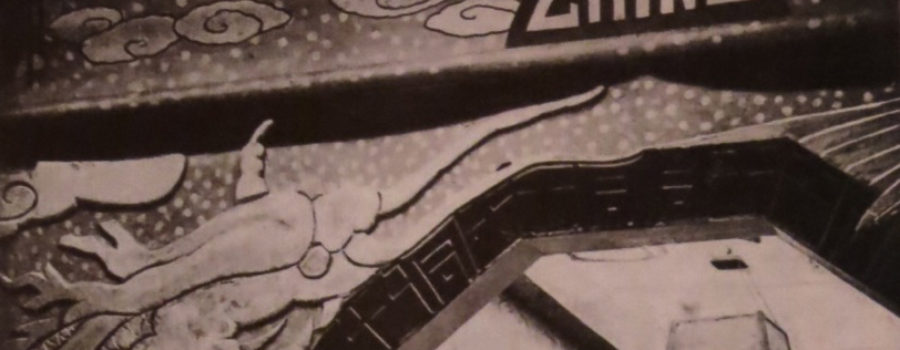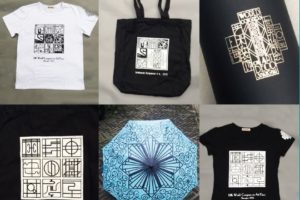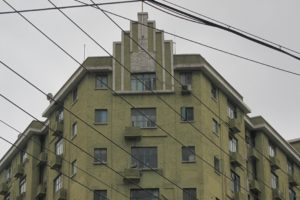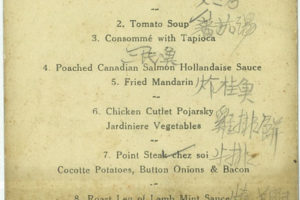In 1925, the International Exposition of Modern Industrial and Decorative Arts* gathered a groundbreaking display of modern decorative arts in Paris that established the Art Deco style. It was emblematic of the times that the United States declined to participate because “there was no modern design in America”, but China was represented, with a striking Chinese Art Deco section designed by the artist and architect Liu Jipiao (刘既漂).
China in 1925 was a relatively new republic, and younger citizens like Liu were eager to modernize and strengthen their country. People of Liu’s generation grew up in a relatively cosmopolitan China, one that was open to trade and international influences following its defeat in the 19th century Opium Wars. Yet China was also humiliated by this loss at the hands of foreigners which led many young Chinese to explore modernizations that were not synonymous with westernization –modernization with Chinese characteristics.
There are only a few images of Liu’s Chinese pavilion, but those that exist show this dream of a Chinese modernization in visual form: traditional motifs of classical Chinese imagery – clouds and three-toed scaly dragons – are streamlined and modernized. Liu designed the cover of the catalogue as well, also featuring classical Chinese imagery in a dramatic modern style, and the first modernizations of Chinese characters to match this new style. It was the first melding of Chinese elements with Art Deco, a uniquely Chinese style that was later embraced by a generation of Chinese architects and artists.
So who was Liu Jipiao, this pioneer of Chinese Art Deco? Born on June 4, 1900 in Meizhou, Guangdong Province, to Hakka parents, he was one of eight children of an affluent family that owned a silk dye factory. Liu was drawn to art at an early age – as a child, he watched and learned from the nearby porcelain factories of Jingdezhen, the imperial “Porcelain Capital”, and during his teenage years, he studied Chinese and Western painting in Shanghai.
As with many sons of wealthy families, he was sent abroad to study: at the age of 19, he began studying French in Paris, and in 1922 enrolled in L’Ecole Nationale des Beaux Arts under the tutelage of the neo-impressionist painter Ernst Laurent. (Significantly, many of the great Chinese Art Deco architects also studied the Beaux Arts tradition, with Paul Philippe Cret at the University of Pennsylvania.) The more Liu studied Western art, the more he was fascinated by the idea of combining Western and Eastern principles to create a modern art form. Along with his friend Lin Fengmen (林風眠), he tested his theories of East-meets-West art at the Strasbourg Expo of 1924, a precursor to the Paris Expo.
Liu returned to China upon graduation in 1927, and a year later co-founded the National Academy of Art (国立美术院) in Hangzhou, where he served as professor and head of the design department. By 1933, he was a professor of art and architecture at Nanjing Central University. Modernizing and strengthening China remained a priority for Liu and his colleagues, and they firmly believed that the key was cultural exchange and education.

The entrance to the West Lake Expo, Hangzhou 1929
With his experience at the Strasbourg and Paris Expos, Liu was the natural choice to be the main architect for the 1929 West Lake Exposition (杭州西湖博覽會) in Hangzhou, with buildings and pavilions once again combining East and West, Art Deco and Chinese. Liu felt that the international exposition would bring Western art influence to China, and act as a force for modernization. The event opened on June 6, 1929, lasted 137 days, featuring over 14 million items and attracting 20 million visitors. It was such an important international exposition, and the buildings so iconic, that when Shanghai hosted the World Expo in 2010 they based the China Pavilion on Liu’s Educational Pavilion, with its streamlined Chinese roof.
With the West Lake Expo completed, Liu turned his attention to building and architecture. In 1929, he launched the construction company Da Fang (大方), and in 1932 an architectural firm of the same name. Da Fang built modern-style structures including homes in Shanghai, Nanjing, and Guangzhou. Along with many of China’s top architects, he was involved in Chiang Kai-shek’s Nanjing Capital Plan, and designed the Chinese Art Deco National Government Building (国民政府) in Nanjing.
In 1937, as Japanese invasion loomed, Liu closed his businesses and was appointed Lieutenant General and Chief Architect in charge of fortifying Guangdong. The political climate was changing, and as the Communist Party began rising to power, Liu’s ties to the Guomindang became an issue. He fled with his family to the United States in January 1947, leaving behind three homes, much of their wealth and possessions, and one baby daughter, whom they assumed they would be able to retrieve quickly. It would be eight years before they saw her again.
In America, unable to speak English or practice architecture, Liu purchased a laundromat, and later a chicken farm, but struggled both financially and with depression. By the 1960s, he began practicing as an architect again, and in retirement, took up painting, teaching and promoting intercultural awareness, his great passions. The first Chinese Art Deco architect died in 1992, just two months short of his 92nd birthday. It was a very different journey than the one he had imagined for himself and for China when he designed that first modernist China dream in 1925, but his pioneering “China Dream” lives on.
*The term “Art Deco” comes from this 1925 exhibition, although it was only coined in the 1960s.
_________________________________________________________________________
Sources
Special thanks to Jennifer Wong and the Liu family – their Liu Jipiao website is a treasure trove of resources: www.liujipiao.com
http://www.vam.ac.uk/content/articles/a/the-1925-paris-exhibition/
http://www.iias.nl/sites/default/files/IIAS_NL65_0607.pdf
http://en.xh-expo.com/pages/history.html
http://liujipiao.com/biography








Most Commented Posts